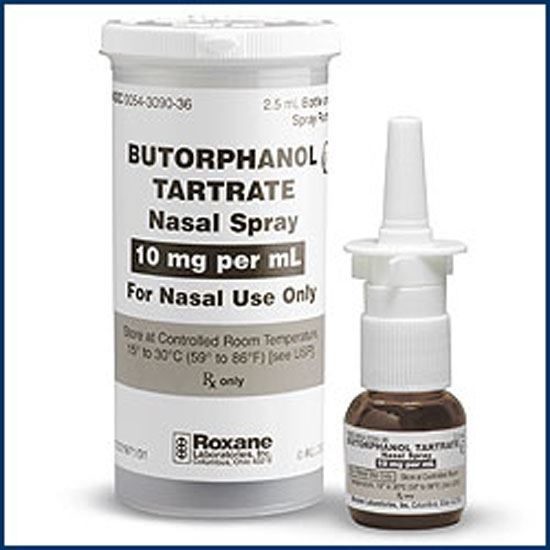
butorphanol tartrate – nasal, Stadol NS
Medication Uses How To Use Side Effects Precautions Drug Interactions Overdose Notes Missed Dose Storage: This medication is used to treat moderate to severe pain, including pain from surgery, muscle pain, and migraine headaches. Butorphanol is a narcotic pain reliever that acts on certain centers in the brain to provide pain relief. It can also block the effects of narcotics and cause withdrawal symptoms in people dependent on narcotics. If possible, individuals who have recently used narcotics in high doses or for a long time should avoid using butorphanol. (See Side Effects section.)
Read the Medication Guide and Patient Information Leaflet provided by your pharmacist before using butorphanol and each time you get a refill. If you have any questions, ask your doctor or pharmacist. This medication is a nasal spray. Have your doctor or pharmacist show you how to use the nasal spray properly. For best results, gently blow your nose before using. Follow the patient instruction leaflet for priming the pump before first use. If the spray has not been used in 48 hours, you may need to prime the pump again before use. Use 1 spray in 1 nostril or as directed by your doctor. If you still have pain after 60-90 minutes, your doctor may direct you to use a second spray in the other nostril. If needed, butorphanol may be used again in 3-4 hours after the second spray or as directed by your doctor. Some individuals may require 2 sprays at the same time. In this case, they should remain lying down due to a higher risk of drowsiness and dizziness with this higher dose. Follow your doctor’s instructions carefully. The dosage is based on your medical condition and response to therapy. Do not increase the dose or use it more often than directed. Pain medications work best when used at the first signs of pain. If you wait until the pain worsens, the medication may not work as well. This drug can cause a drop in blood pressure, especially within the first hour after use. This can result in dizziness, lightheadedness, and fainting. To reduce this risk, remain sitting or lying down after using this medication. If you use a nasal decongestant spray (e.g., oxymetazoline), it may slow down the effect of this pain medication. Consult your doctor or pharmacist about using these 2 medications. If nausea occurs, consult your doctor or pharmacist for ways to decrease it (e.g., antihistamines, lying down with minimal head movement). This medication may cause withdrawal reactions, especially if used regularly for a long time or in high doses. Withdrawal symptoms such as restlessness, runny nose, watering eyes, trouble sleeping, severe abdominal/muscle pain, nausea, vomiting, rapid breathing, and fast heartbeat may occur if you suddenly stop using this medication. To prevent withdrawal reactions, your doctor may gradually reduce your dose. Consult your doctor or pharmacist for more details, and report any withdrawal reactions immediately. Rarely, abnormal drug-seeking behavior (addiction) may occur with this medication. Do not increase your dose, use it more frequently, or use it for a longer time than prescribed. Properly stop the medication when directed to do so. This medication may not work as effectively and may require different dosing if used for an extended period. Talk to your doctor if this medication stops working well. Inform your doctor if your pain persists or worsens.
Side Effects: Drowsiness, dizziness, blurred vision, flushing, headache, nausea, vomiting, constipation, nasal irritation/congestion, trouble sleeping, dry mouth, and sweating may occur. If any of these effects persist or worsen, contact your doctor or pharmacist promptly. To prevent constipation, maintain a fiber-rich diet, drink plenty of water, and exercise. If you become constipated while using this drug, consult your pharmacist for help with selecting a laxative. Your doctor has prescribed this medication because the benefit to you is greater than the risk of side effects. Many individuals using this medication do not experience serious side effects. Butorphanol can cause withdrawal reactions in people who are physically dependent on narcotics. The severity of the withdrawal symptoms depends on the level of dependence and dose of butorphanol. Inform your doctor immediately if you develop symptoms such as anxiety, agitation, trouble sleeping, sweating, stomach cramps, and diarrhea. Tell your doctor right away if you experience any serious side effects, including nosebleeds, mental/mood changes, fast/slow/irregular heartbeat, severe stomach/abdominal pain, change in urine output. Seek immediate medical help if you have any very serious side effects, including difficult/slow/shallow breathing and seizures. A severe allergic reaction to this drug is rare. However, seek medical help immediately if you notice any symptoms of a serious allergic reaction, including rash, itching/swelling, severe dizziness, and difficulty breathing. This is not a complete list of possible side effects. Contact your doctor or pharmacist if you experience other effects not listed above. In the US – Call your doctor for medical advice about side effects. You may report side effects to the FDA at 1-800-FDA-1088. In Canada – Call your doctor for medical advice about side effects. You may report side effects to Health Canada at 1-866-234-2345.
Precautions: Before using butorphanol, tell your doctor or pharmacist if you are allergic to it or if you have any other allergies. This product may contain inactive ingredients that can cause allergic reactions or other problems. Talk to your pharmacist for more details. Before using this medication, tell your doctor or pharmacist about your medical history, especially if you have abdominal problems, adrenal gland problems, brain disorders, heart problems, high blood pressure, kidney disease, liver disease, breathing problems, mental/mood disorders, spinal problems, stomach/intestinal problems, a history of drug/alcohol use, difficulty urinating, or an underactive thyroid. This drug may make you dizzy or drowsy. Do not drive or engage in activities that require alertness until you are sure you can do so safely. Avoid alcoholic beverages. To lower your risk of dizziness and lightheadedness, get up slowly when rising from a sitting or lying position. Older adults may be more sensitive to the side effects of this drug, especially confusion, dizziness, drowsiness, and slow/shallow breathing. Women of childbearing age should discuss the risks and benefits of this medication with their doctor(s) before using it. Tell your doctor if you are pregnant or planning to become pregnant. This medication should only be used during pregnancy when clearly needed. It may slightly increase the risk of birth defects if used during the first two months of pregnancy. Additionally, using it for a long time or in high doses close to the expected delivery date may harm the unborn baby. To minimize the risk, take the smallest effective dose for the shortest duration possible. Notify your doctor immediately if you notice any symptoms in your newborn baby, such as slow/shallow breathing, irritability, abnormal/persistent crying, vomiting, or diarrhea. This drug passes into breast milk. Consult your doctor before breast-feeding.
QUESTION
Drug Interactions: Drug interactions may change how your medications work or increase your risk for serious side effects. This document does not contain all possible drug interactions. Keep a list of all the products you use (including prescription/nonprescription drugs and herbal products) and share it with your doctor and pharmacist. Do not start, stop, or change the dosage of any medicines without your doctor’s approval. Some products that may interact with this drug include MAO inhibitors, narcotic blockers, and nasal decongestants. The risk of serious side effects (such as slow/shallow breathing, severe drowsiness/dizziness) may increase if this medication is taken with other products that affect breathing or cause drowsiness. Therefore, inform your doctor or pharmacist if you are using other products such as alcohol, sleep/anti-anxiety medications, muscle relaxants, and narcotic pain relievers. Check the labels of all your medications (including cough-and-cold products) as they may contain ingredients that cause drowsiness. Inform your doctor if you are taking medications that may interfere with certain laboratory tests or having an overdose suspected. Notes: Do not share this medication with others as it is against the law. This medication has been prescribed for your current condition only. Do not use it later for another condition unless directed to do so by your doctor. A different medication may be necessary in that case. Storage: Store this medication at room temperature away from light and moisture. Do not store in the bathroom. Keep all medications away from children and pets. Do not flush medications down the toilet or pour them into a drain unless instructed to do so. Properly discard this product when expired or no longer needed. Consult your pharmacist or local waste disposal company. Information last revised March 2013. Copyright(c) 2013 First Databank, Inc.


